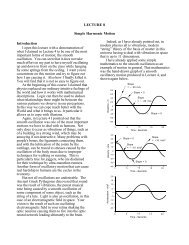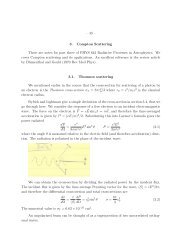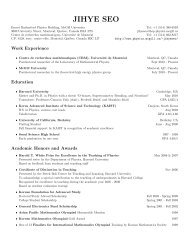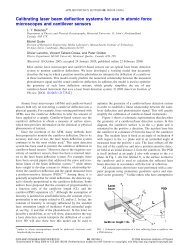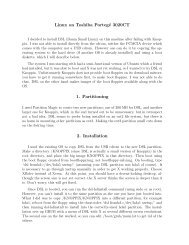LECTURE 24 Bending Moments (Torques) and ... - McGill Physics
LECTURE 24 Bending Moments (Torques) and ... - McGill Physics
LECTURE 24 Bending Moments (Torques) and ... - McGill Physics
You also want an ePaper? Increase the reach of your titles
YUMPU automatically turns print PDFs into web optimized ePapers that Google loves.
"Give me a lever long enough <strong>and</strong> a place<br />
to st<strong>and</strong> <strong>and</strong> I will move the earth"<br />
Archimedes (circa 340 BC)<br />
Introduction<br />
Previously I introduced the concept of<br />
equilibrium of forces; that for an object to be<br />
stationary any force acting on it must be balanced<br />
by another force that makes the net force zero.<br />
However, it was known from antiquity that<br />
this was not enough to make sure that the object<br />
did not move. For example, two objects sitting<br />
on opposite ends of a balance bar will only result<br />
in the balance bar not moving when the two have<br />
the same weight.<br />
A<br />
TO BALANCE A AND B MUST BE THE SAME WEIGHT<br />
This device was well known since it is the<br />
basis of the balance from which the word<br />
"balance" itself has been derived <strong>and</strong> which has<br />
been used in trade from the very beginning of<br />
history.<br />
Clearly, in such a device the requirement is<br />
not that the forces balance as in the previous<br />
lecture. The forces are both downward, i.e. in the<br />
same direction. They are actually balanced by the<br />
force on the pivot point, which must support both<br />
weights. For example, if each weight was 250 N<br />
(i.e. about 25 kg but remember my promise not to<br />
use kg as force), then the pivot point would push<br />
up with a force of 500 N.<br />
250 N 250 N<br />
500 N<br />
<strong>LECTURE</strong> <strong>24</strong><br />
<strong>Bending</strong> <strong>Moments</strong> (<strong>Torques</strong>)<br />
<strong>and</strong> Forces in the Human Body<br />
B<br />
In what sense then do the 250 N forces<br />
themselves balance?<br />
Another Demonstration<br />
As an example of the importance of this<br />
question, consider another demonstration. I<br />
clamp a board to the end of the table so that it<br />
overhangs by about 80 cm. Then, with the help<br />
of a student who sits on the other end of the table<br />
to keep it steady, I ease myself sideways out<br />
along the board past the edge of the table.<br />
You will clearly see that the board bends more<br />
<strong>and</strong> more as I move out from the table edge.<br />
When I am about 60 cm from the table edge, the<br />
board actually breaks. That there is a very large<br />
force involved is indicated by the loud crack when<br />
the board broke.<br />
From the point of view of simple equilibrium<br />
of forces, this makes no sense. I did not get any<br />
heavier as I moved out on the board. Therefore<br />
the board was not asked to provide an increased<br />
reaction force as I moved out. It had always to<br />
support only my weight, which it was seen to<br />
easily do when I was close to the edge of the<br />
table. Neither was there a change in the direction of<br />
the forces so as to give some amplification due to<br />
force triangulation, as there was in the case of my<br />
pulling on a cable in the demonstration of Lecture<br />
19. My weight <strong>and</strong> the force of the board on my<br />
feet were always in opposite direction to each<br />
other.<br />
Where then did the forces that broke the<br />
board come from?
<strong>Physics</strong> 101A - <strong>Physics</strong> for the life sciences 2<br />
Turning <strong>and</strong> Torque<br />
A clue can be found in the bending of the<br />
board as I moved out on it. Clearly, the board<br />
was being turned downward by my weight <strong>and</strong> it<br />
was this turning which the board had to resist.<br />
But how do you resist a turn? Obviously by<br />
trying to turn the other way.<br />
But what is a turning effort <strong>and</strong> how is it<br />
balanced?<br />
This can be seen by considering the case of a<br />
balance in which the weights are not equal. To<br />
keep the case simple, have one of the weights<br />
twice that of the other.<br />
d 2d<br />
A B<br />
IF B IS HALF THE WEIGHT OF A THEN IT MUST BE TWICE<br />
AS FAR FROM THE PIVOT POINT FORIT TO BALANCE B<br />
This situation will be balanced when the<br />
lighter weight is exactly twice as far from the<br />
pivot as the heavier weight.<br />
Again this fact was known from antiquity. It<br />
also seems to be fairly obvious since even preschool<br />
children learn it. In fact, it is used as a<br />
Piaget-type test of the intellectual development of<br />
young children.<br />
The same is true for any combination of<br />
weights. Thus the "balancing power" of a weight<br />
is the product of the weight times its distance<br />
from the pivot point. This “balancing power" is<br />
often referred to as the "moment" of the weight<br />
about the pivot, <strong>and</strong> the distance of a force from a<br />
turning point is referred to as its “moment arm”.<br />
The moment of a force is also often referred<br />
to as a "torque" about the pivot. Both words are<br />
synonymous. (You might wonder at this strange<br />
use of the word moment. It is based on the old<br />
English meaning of "moment" as importance,<br />
rather than as in its other meaning as a short<br />
period of time. Thus the moment of a force can<br />
be thought of as the importance of a force, where<br />
its importance is related to how far it is from a<br />
pivot point. The word torque is easier in that it<br />
derives from the Latin word for twist.)<br />
Thus, for an object such as a balance beam to<br />
be in true equilibrium, the torques (i.e. moments)<br />
on it must balance. This means that a torque<br />
tending to turn the beam clockwise, i.e. th etorque<br />
caused by B in the above diagram, must be<br />
balanced by a torque tending to turn the beam<br />
counterclockwise, i.e. from A in the diagram..<br />
But where were the forces that were creating<br />
the counterclockwise torque that was resisting my<br />
clockwise torque on the board?<br />
The Torque of Couples<br />
A further clue as to where these forces were is<br />
that when the board is bent downward from my<br />
weight the top surface becomes stretched while<br />
the bottom surface becomes compressed. There<br />
must then be a tension in the top part of the board<br />
resisting it from being pulled apart <strong>and</strong> a<br />
compression in the bottom part resisting it from<br />
being crushed.<br />
TOP BEING STRETCHED<br />
BOTTOM BEING CRUSHED<br />
Now consider the board as being of two parts<br />
each applying these forces to each other.<br />
Consider the free body diagram for the piece I<br />
was st<strong>and</strong>ing on. The tension <strong>and</strong> compression<br />
forces are acting on this piece of board as shown<br />
in the diagram below<br />
Such a set of forces form what is called a<br />
"couple". In such a couple the forces are indeed<br />
equal <strong>and</strong> opposite but their lines of force are<br />
separated. The forces themselves then actually<br />
balance but the torques do not. A "couple"<br />
therefore provide a pure torque, equal to either<br />
one of the forces (remember they are both of the<br />
same magnitude) multiplied by the distance<br />
between their lines of action.<br />
As an exercise in the concept of a couple,<br />
consider two parallel forces of 200 N in opposite<br />
directions being applied to a bar at points which<br />
are 0.25 m apart.
Lecture <strong>24</strong> - <strong>Bending</strong> <strong>Moments</strong> <strong>and</strong> Forces in the Human Body 3<br />
200 N<br />
0.25 m<br />
200 N<br />
Take the torques about the point of<br />
application of the force on the left. Having no<br />
distance from that point, the left force provides no<br />
torque (i.e. has no moment). The torque then is<br />
all due to the force on the right. It is clockwise<br />
which, as for angles, is considered negative. Its<br />
value is −200N × 0.25 m = −50 N-m.<br />
Now consider the same situation but calculate<br />
the torques about the point of application of the<br />
force on the right. Now the force on the right<br />
provides no torque <strong>and</strong> all the torque is being<br />
provided by the force on the left. This is also<br />
seen to be clockwise <strong>and</strong> −50-N-m.<br />
Now consider the torques about the middle of<br />
the bar. Here each force provides a clockwise<br />
torque but each torque is only −200N × 0.125 m,<br />
or −25 N-m. However, again the total torque is<br />
−50 N-m.<br />
Finally consider the torques about a point at x<br />
meters to the right of the right end of the bar.<br />
200 N<br />
0.25 m<br />
200 N<br />
Now the torques are 200N × x m= 200x N-m<br />
for the right force (it is positive because it is now<br />
counterclockwise) <strong>and</strong> −200N × (x +0.25)m for<br />
the left force. The sum of these is again<br />
−50 N–m.<br />
Thus it does not matter where we take the<br />
point about which to calculate the torque. For a<br />
x<br />
couple it is always the same. Since there is no net<br />
force in a couple, a couple is a pure torque.<br />
The Forces that Broke The Board<br />
What held me up before the board broke was<br />
the moment of the couple created by the tension<br />
in the top of the board <strong>and</strong> the compression in the<br />
bottom of the board.<br />
Consider now the torque that I applied to the<br />
board just when it broke. I am about 75 kg which<br />
means that my weight is about 750 N. When the<br />
board broke I was about 60 cm (0.6 m) from the<br />
edge of the table. My torque on the board at the<br />
edge of the table was therefore about _−750 N<br />
times 0.6 meters, or about −450 N-m. If you<br />
have had the misfortune of dealing with torque<br />
before this lecture you may well have heard it<br />
expressed in kg-cm, or if your were in the<br />
backward part of the world called the US, in<br />
pound-feet (lb-ft). If you have kg-cm then divide<br />
by 10, roughly, to get N-m. If you have lb-ft then<br />
divide by 7, very roughly.<br />
The torque that must resist this torque, i.e.<br />
must balance it, comes from a couple that has, at<br />
most, a separation which is the thickness of the<br />
board, or only 20 mm or 0.02 m. To provide a<br />
torque of 450 N-m the forces in this couple must<br />
be at least 22500 N each! (If you are still not<br />
used to Newtons, this is just over 2 Tonnes!) It is<br />
clear that such forces could easily break the<br />
board. In fact it is remarkable that the board<br />
could even support me out to the distance that it<br />
did.<br />
Actually, because the forces of tension <strong>and</strong><br />
compression are distributed throughout the<br />
thickness of the board the average separation of<br />
the forces is less than 2 cm. 22500 N would be<br />
the force only if all the tension <strong>and</strong> compression<br />
was restricted to the top <strong>and</strong> bottom of the board.<br />
The ability of the board to withst<strong>and</strong> my weight is<br />
therefore even more remarkable.<br />
The Creation of Large Forces in Your Body<br />
The building up of tremendous forces in the<br />
board used in this demonstration might seem of<br />
academic interest, <strong>and</strong> then only of interest to<br />
physicists. However, it does illustrate an<br />
extremely important phenomenon relating to the<br />
human backbone. If you have ever worked in a<br />
job that required lifting objects you will have<br />
come across signs telling you to lift with your<br />
legs, not you back. The reason for such signs is<br />
that by bending over from your hips with your<br />
back straight, even before you pick up the object,
<strong>Physics</strong> 101A - <strong>Physics</strong> for the life sciences 4<br />
you will put about 4000N (400 kg) of<br />
compression on your backbone. The diagram<br />
below should illustrate why this happens.<br />
HIP<br />
0.30 m<br />
400 N<br />
(40 kg)<br />
When you bend over the upper part of your<br />
body applies a torque about your hips that tends<br />
to turn the body downward (clockwise in the<br />
diagram). This torque is about that which would<br />
result from your upper body weight, typically<br />
400N (40 kg), applied at a distance of about<br />
300 mm (0.3 m) from your hips. The resulting<br />
torque about your hips is therefore about<br />
120 N–m.<br />
This torque must be resisted by something, or<br />
your upper body just falls down. That<br />
something is, of course, the pull of your major<br />
back muscle between your hip <strong>and</strong> your upper<br />
backbone. This force, in turn, puts an equal force<br />
of compression on your backbone. These forces,<br />
the pull of your back muscle against the push of<br />
your backbone, together form a couple of the<br />
torque required to balance the torque from the<br />
weight of your upper body.<br />
The typical separation between your lower<br />
back muscle, which provides the tension, <strong>and</strong><br />
your backbone, which provides the compression,<br />
is only about 3cm. The counterclockwise torque<br />
generated by this must balance the clockwise<br />
torque from your upper body weight. It must<br />
therefore be 120 N-m. At a couple separation of<br />
0.03 m, the forces must be 4000N (400 kg). Such<br />
forces are easily capable of either causing severe<br />
strain on the back muscle, or fracture of the<br />
backbone, or both, particularly if you are out of<br />
shape or not used to lifting heavy weights.<br />
SPINE<br />
HIP<br />
LOWER BACK MUSCLE<br />
SPINE<br />
LOWER BACK<br />
MUSCLE<br />
400 N<br />
(40 kg)<br />
3 cm<br />
Another example of torques generating severe<br />
forces within the human body is that of<br />
supporting an object in your h<strong>and</strong> when you<br />
stretch out your arm. Here there are two major<br />
joints about which torques have to be resisted,<br />
that of the elbow <strong>and</strong> that of the shoulder.<br />
SHOULDER<br />
ELBOW<br />
Because of the greater distance of the force<br />
from the shoulder, the torque at the shoulder will<br />
be greater than the torque at the elbow. Nature<br />
seems to know this by making the shoulder much<br />
sturdier than the elbow.<br />
As an example, suppose the distance from a<br />
1 kg ball to your elbow joint was 35 cm <strong>and</strong> the<br />
distance from your elbow joint to your shoulder<br />
joint was another 35 cm. The torque that would<br />
have to be generated by your forearm muscle<br />
would then be about 3.5 N-m but the torque that<br />
would have to be provided by your bicep would<br />
be 7 N-m.<br />
This also shows why the board broke exactly<br />
at the edge of the table. (I knew this was going to<br />
happen so that the piece of the board that broke<br />
off would stay intact under my feet, providing a
Lecture <strong>24</strong> - <strong>Bending</strong> <strong>Moments</strong> <strong>and</strong> Forces in the Human Body 5<br />
l<strong>and</strong>ing pad as I approached the floor.) The<br />
torque required to prevent the board from turning<br />
increases for increased distance from my feet.<br />
The torque needed to overcome the torque I apply<br />
to the board is therefore a maximum at the table<br />
edge. Since this torque must be provided by<br />
internal forces within the board, these forces are<br />
also greatest at the table edge, <strong>and</strong> therefore that is<br />
where it broke.<br />
The Concept of Center of Mass<br />
So far I have treated all masses as points at<br />
specific places relative to a center of rotation.<br />
How valid is this? For example, how valid was it<br />
for me to assume that the mass of my upper body<br />
when I bent over acted as if it was concentrated at<br />
a point 30 cm from my hips?<br />
As a start to this subject consider again the<br />
two unequal masses on a balance. To make the<br />
arithmetic simple, suppose they have masses of<br />
1 kg <strong>and</strong> 2 kg <strong>and</strong> are balanced at distances of<br />
1.0 m <strong>and</strong> 0.5 m respectively.<br />
2 kg<br />
0.5 m 1.0 m<br />
1 kg<br />
Now consider the torque of the two masses if<br />
the “balance” point is under the 2.0 kg mass.<br />
2 kg<br />
0.5 m 1.0 m<br />
1 kg<br />
Now only the 1 kg mass provides any torque,<br />
<strong>and</strong> that is −1.5 kg-m. Note that this is the same<br />
as the total weight of the two masses together, i.e.<br />
3 kg, at a moment arm of 0.5 m. This moment<br />
arm is simply the distance of the actual balance<br />
point from the new turning point.<br />
Next consider the torque of the two masses if<br />
the “balance” point is under the 1.0 kg mass.<br />
2 kg<br />
0.5 m 1.0 m<br />
1 kg<br />
Now only the 2 kg mass provides any torque,<br />
<strong>and</strong> that is 3.0 kg-m. Note that this is the same as<br />
the total weight of the two masses together, i.e.<br />
3 kg, at a moment arm of 1.0 m. This moment<br />
arm is again simply the distance of the actual<br />
balance point from the new turning point.<br />
Finally, consider the torque of the two masses<br />
if the “balance” point was moved to an arbitrary<br />
distance x to the left of the actual balance point.<br />
2 kg<br />
x<br />
0.5 m 1.0 m<br />
1 kg<br />
Now both masses provide a negative torque, a<br />
total of −1 kg × (1+x)m −2 kg × (x-0.5)m.<br />
Doing the algebra this becomes simply 3x N-m<br />
Yet again, this is just the total mass times the<br />
distance of the original balance point from the<br />
new turning point, i.e. x.<br />
Thus, for the torques they produce, the two<br />
masses always act as if their total mass was<br />
concentrated at the balance point between them.<br />
This point is therefore called the “center of<br />
mass”.<br />
Sometimes the center of mass is referred to<br />
as the “center of gravity”. But there does not<br />
have to be any gravity for the center of mass to<br />
exist. It comes just from the distribution of the<br />
masses making up a system. (This will be<br />
important in the next lecture which will be about<br />
rotational dynamics.)<br />
How then, for a general case such as the<br />
human body, do we find out where the center of<br />
mass actually is? In principle, if you knew the<br />
mass of all the body parts, <strong>and</strong> where they were<br />
concentrated, you could calculate it, <strong>and</strong> in<br />
modern ergonomics these sorts of calculations<br />
are actually carried out, helped a great deal by<br />
modern computers. However, it is usually much<br />
simpler to determine the center of mass by<br />
determining the balance point experimentally. In<br />
the case of my body, this can be determined by<br />
me stretching out on a bar <strong>and</strong> adjusting my<br />
position on the bar until I am balanced.
<strong>Physics</strong> 101A - <strong>Physics</strong> for the life sciences 6<br />
MY CENTER OF MASS MUST HAVE<br />
BEEN ALONG THIS LINE OR I<br />
WOULD HAVE NOT BALANCED<br />
I then know that my "center of mass" is over<br />
the pivot point. If it were not then the force vector<br />
of my weight would not pass through the pivot<br />
point <strong>and</strong> I would be unbalanced. I will ignore<br />
snide remarks concerning that being my normal<br />
state <strong>and</strong> just point out that my center of mass<br />
seems to be somewhere around my pelvis.<br />
Of course, it takes the crossing of two lines to<br />
determine the position of any point such as my<br />
center of mass. In the case of me being stretched<br />
out, this second line is easy to determine.<br />
St<strong>and</strong>ing erect requires that my center of mass be<br />
over the point I am st<strong>and</strong>ing on. Otherwise I<br />
would topple over. In fact the great ability of<br />
human beings compared to other animals is the<br />
ease with which they can adjust their posture so<br />
that their centers of mass are directly over their<br />
feet. I can then draw a vertical line through my<br />
body <strong>and</strong> the intersection of this line with the line<br />
corresponding to the height of my pelvis will give<br />
me my center of mass.<br />
MY CENTER OF MASS MUST HAVE<br />
BEEN ALONG THIS LINE OR I WOULD<br />
NOT BE BALANCED ON MY FEET<br />
CENTER OF MASS<br />
The remarkable thing about the center of<br />
mass concept is that it can be used to determine<br />
the torque of an object about any pivot point just<br />
by knowing the objects weight. All that you have<br />
to do is take the total weight of the object <strong>and</strong><br />
multiply it by the distance of the line of action of<br />
this weight from the pivot point, a distance which<br />
I have already referred to as the "moment arm" of<br />
the force.<br />
MOMENT ARM<br />
PIVOT POINT<br />
FORCE<br />
This was the basis of the statement earlier that<br />
the torque of my upper body against my hip<br />
when I bend over is equivalent to the weight of<br />
my upper body being applied at about 30 cm<br />
from my hips. This is because the center of mass<br />
of my upper body is at this point, giving a<br />
moment arm of 0.3 m when I bend over.<br />
An intriguing thing about the center of mass<br />
is that it can be outside your body! Consider, for<br />
example, when I bend over as in the forbidden<br />
pick up exercise. You can see from where I have<br />
to keep by feet that my center of mass has now<br />
moved forward from my pelvis. This is because it<br />
must be somewhere along the vertical line<br />
running to the soles of my feet.<br />
MY CENTER OF MASS IS<br />
ALONG THIS LINE<br />
To determine where it actually is along this<br />
line I must balance myself in this same<br />
configuration but about a different point. I can
Lecture <strong>24</strong> - <strong>Bending</strong> <strong>Moments</strong> <strong>and</strong> Forces in the Human Body 7<br />
choose to do so by again balancing myself on the<br />
bar with the bar in my crotch.<br />
MY CENTER OF MASS IS<br />
ALONG THIS LINE<br />
Combing these two diagrams into one gives<br />
the intersection of the two lines <strong>and</strong> hence the<br />
point of the center of mass.<br />
MY CENTER OF MASS IS<br />
ALONG THIS LINE<br />
MY CENTER OF MASS IS<br />
ALSO ALONG THIS LINE<br />
CENTER OF MASS<br />
My center of mass is obviously outside my<br />
body. A remarkable consequence of this fact is<br />
that by the proper movements a jumper can pass<br />
over a bar while his or her center of mass actually<br />
passes underneath it. This is shown in a<br />
photograph of the so-called "Fosbury flop" in<br />
Hecht.<br />
A final point of importance in underst<strong>and</strong>ing<br />
torque concerns the distance of the force from a<br />
pivot point. This is not necessarily the distance<br />
of the point of application of the force from the<br />
pivot point. A familiar example of this should be<br />
the torque you apply to the crankshaft of a<br />
bicycle as the crankshaft turns. Suppose that you<br />
are pedaling up a hill <strong>and</strong> to get the maximum<br />
torque you st<strong>and</strong> up on the pedal that is forward.<br />
You have probably experienced the fact that the<br />
effect of your pedaling is much greater in the<br />
middle of the stroke when the crankshaft is<br />
horizontal then at the beginning of the stroke, or<br />
near its end.<br />
Maximum torque<br />
W<br />
W<br />
W<br />
Much reduced torque<br />
The torque of a force applied to a point that is<br />
not on a perpendicular line from the pivot point is<br />
represented in the diagram below (<strong>and</strong> in figure<br />
8.13 of Hecht).<br />
MOMENT ARM<br />
= r<br />
LINE OF ACTION<br />
OF FORCE<br />
PIVOT POINT<br />
r<br />
θ<br />
FORCE<br />
The torque that this force applies at the pivot<br />
point is not the product of the force <strong>and</strong> the<br />
distance of its point of application from the pivot.<br />
Rather it is the distance of the line of force from<br />
the pivot point, or r in the diagram (previously<br />
referred to as the "moment arm"). That is<br />
τ = Frsinθ
<strong>Physics</strong> 101A - <strong>Physics</strong> for the life sciences 8<br />
Another way to look at the torque of a force<br />
applied to a point that is not on a perpendicular<br />
line from the pivot point is to consider the force<br />
as being resolved into two components, one along<br />
the line to the pivot point <strong>and</strong> the other<br />
perpendicular to that line.<br />
PIVOT POINT<br />
r<br />
The force component along the line (F )<br />
points directly away from the pivot point. It<br />
therefore provides no torque. The torque is then<br />
all provided by the perpendicular component,<br />
which is Fsinθ . The torque is therefore again<br />
τ = Frsinθ<br />
The torque is therefore the same as that<br />
obtained by taking the full force <strong>and</strong> multiplying<br />
it by the moment arm.<br />
F<br />
θ<br />
F<br />
F<br />
Summary<br />
In summary, we have a second condition for<br />
equilibrium; that the sum of all the torques on an<br />
object must balance. This is the second<br />
governing principle, along with the equilibrium of<br />
forces, in the very important subject of "Statics"<br />
in Engineering <strong>and</strong> <strong>Physics</strong>. It is very important<br />
to realize that it is not just that one or the other of<br />
these principles will apply to specific cases.<br />
Rather, both principles apply all the time <strong>and</strong><br />
between them they form the basis of how forces<br />
move objects.<br />
Relevant material in Hecht<br />
Section 8.4 subsection “Rotational<br />
Equilibrium”. Appropriate problems - worked<br />
examples in the text <strong>and</strong> 69 to 127 (59-97 2 nd<br />
edition) at the end of the chapter.






